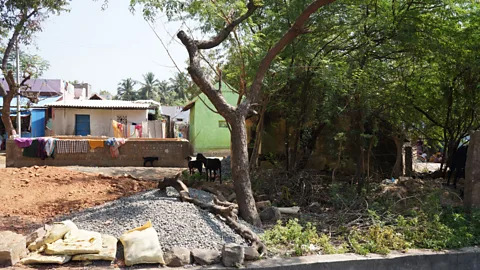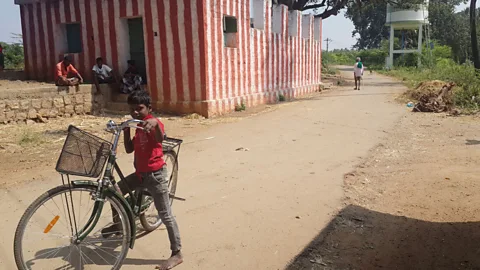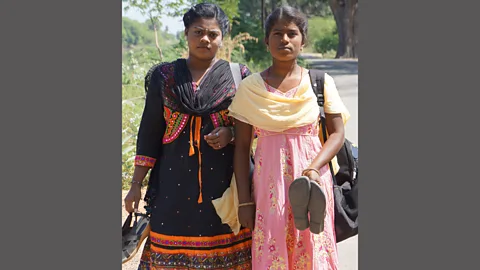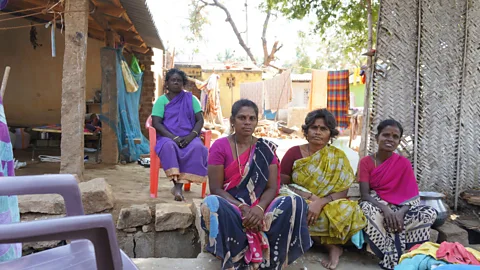The tiny Indian village that banned shoes
 Kamala Thiagarajan
Kamala ThiagarajanIn a country where people often go barefoot indoors – considering it a gesture of respect and a nod to hygiene – a village in southern India has taken the practice to a new level.
As an Indian, I’ve always been comfortable with the notion of bare feet. Over the years, I’ve grown accustomed to slipping out of my shoes before stepping into my own home (to not bring germs indoors with me), when I visit friends and family, or during prayers at Hindu temples.
And yet, despite this conditioning, even I was unprepared for Andaman.
 Kamala Thiagarajan
Kamala ThiagarajanA village in the southern Indian state of Tamil Nadu, Andaman is 450km (and around a 7.5-hour drive) from Tamil Nadu’s capital city of Chennai. Around 130 families live here, many of whom are agricultural labourers who work in the surrounding paddy fields.
You may also be interested in:
• The descendants of Alexander the Great?
I met 70-year-old Mukhan Arumugam just as he was offering his daily prayers under an enormous neem tree at the entrance to the village. Dressed in a white shirt and a checked lungi (sarong), his face was tilted to the sky. Even in late January, the midday sun was blindingly bright.
It is under this tree, he said, adjacent to the sparkling waters of an underground reservoir and engulfed by lush green paddy fields and rock-strewn roads, that the story that defines his village begins. For this is the exact spot where villagers take off their sandals or shoes and carry them in their hands when they enter the village.
No-one in the village of Andaman, except the very elderly and the infirm, wears shoes, Arumugam told me. He was barefoot himself, even though he says he does intend to wear sandals soon, especially in the hot summer months ahead. As I walked through the village in my thick dark socks, I was astounded by the sight of children and teenagers rushing to school and couples strolling to work, all nonchalantly carrying their shoes in one hand. It was almost like they were another accessory, like a purse or a bag.
 Kamala Thiagarajan
Kamala ThiagarajanI stopped 10-year-old Anbu Nithi who whizzed past me on his bicycle in his bare feet. Nithi studies in standard five in a town 5km away, and he grinned when I asked him if he’d ever flouted the barefoot rule of the village. “My mother told me that a powerful goddess called Muthyalamma protects our village and so we don’t wear slippers here out of respect for Her,” he said. “If I wanted to, I could, but that would be like insulting a friend that everyone adores.”
I quickly find that it’s this spirit that sets Andaman apart. No-one enforces the practice. It isn’t a stringent religious code, rather a time-worn tradition that is steeped in love and respect.
“We’re the fourth generation of villagers to live this way,” explained Karuppiah Pandey, a 53-year-old painter. He was carrying his shoes, but his wife, Pechiamma, 40, who works in the fields to harvest rice, says she doesn’t bother with footwear at all except when venturing outside the village. When someone visits the village wearing shoes, they try to explain the rule, she says. But if they don’t comply, it’s never enforced. “It’s purely a personal choice that’s embraced by all who live here,” Pechiamma said. And though she’s never imposed the rule on her four children either – who are now adults and working in nearby cities – they all follow the custom when they come to visit her.
 Kamala Thiagarajan
Kamala ThiagarajanBut there was a time when fear propelled this practice.
“Legend has it that a mysterious fever will strike you if you don’t heed the rule,” said Subramaniam Piramban, 43, a house painter who has lived in Andaman all his life. “We don’t live in fear of this prophecy, but we’ve grown accustomed to treating our village like a sacred space – to me, it’s like an extension of a temple,” he said.
To find out how this the legend evolved, I was directed to the village’s informal historian. Lakshmanan Veerabadra, 62, is a success story of staggering proportions for this little hamlet. Today, he runs a construction company in Dubai, after having travelled overseas as a daily wage labourer nearly four decades ago. He returns to the village often, sometimes to recruit personnel, but mostly to keep in touch with his roots. Seventy years ago, he said, villagers installed the first clay idol of Goddess Muthyalamma under the neem tree on the outskirts of the village. Just as the priest was adorning the goddess with jewellery and people were immersed in prayer, a young man is believed to have walked past the idol with his shoes on. It’s not clear whether this man viewed the ceremony with any degree of scorn, but legend has it he slipped and fell mid-stride. That evening, he was struck with a mysterious fever, and it took him many months to recover.
“Ever since then, the people in the village don’t wear any kind of footwear,” Veerabadra said. “It evolved into a way of life.”
Every five to eight years, during March or April, the village hosts a festival during which a clay idol of Muthyalamma is installed under the neem tree. For three days, the goddess stays to bless the village, before the idol is smashed to pieces and returned to the elements. During the festival, the village is filled with prayer, feasting, pageantry, dance and drama. But because of the huge costs involved, it isn’t an annual affair. The last festival was in 2011, and the next event is uncertain, depending as it does on donations from local patrons.
 Kamala Thiagarajan
Kamala ThiagarajanMany outsiders tend to dismiss the legend at the heart of this village as a kind of odd superstition, says Ramesh Sevagan, 40, a driver. At the very least, he says, the legend has helped carve a strong sense of identity and community. “It has brought us together, made everyone in the village feel like a family,” Sevagan said. This sense of kinship has bred other local customs, too. When someone in the village dies, for instance, regardless of whether the deceased is rich or poor, villagers gift a modest sum – Rs 20 each – to the bereaved family. “Apart from wanting to help our neighbours, to be there for them in good times and in bad, it has made us feel that we’re all equals here,” Sevagan said.
I wonder if time, travel and global exposure can dent this feeling. I asked Dubai-based Veerabadra whether he still feels as strongly about the shoe ban now as he did as a young boy. He says he does. Even today, he goes barefoot in the village and the years away haven’t dampened his enthusiasm for following the legend that lies at the heart of Andaman.
“Regardless of who we are or where we live, all of us wake up every morning believing that we will be well,” he said. “There are no guarantees, but we still go about our day. We make plans for the future; we dream, we think ahead.
“Life everywhere revolves around such simple faith; it’s just another version of this that you see in our village.”
The Customs That Bind Us is a series from BBC Travel that celebrates cultures around the world through the exploration of their distinctive traditions.
more than three million BBC Travel fans by liking us on Facebook, or follow us on Twitter and Instagram.
If you liked this story, sign up for the weekly bbc.com features newsletter called "If You Only Read 6 Things This Week". A handpicked selection of stories from BBC Future, Culture, Capital and Travel, delivered to your inbox every Friday.
{"image":{"pid":""}}
